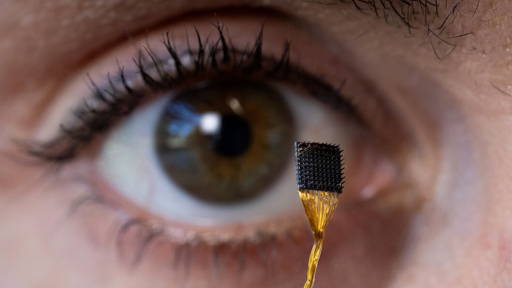An international group of neuroscientists and materials scientists has developed a revolutionary technology: contact lenses that allow humans and animals to perceive near-infrared light. In other words, contact lenses with “night vision”. The lenses convert invisible infrared light (800-1600 nm) into visible light, giving users an extra sense - without any power source or external equipment.
The lenses use nanoparticles that absorb infrared photons and convert them into visible light in the 400-700 nm range. Unlike traditional night vision goggles, the lenses are completely transparent. This allows users to perceive both normal and infrared light simultaneously - and remarkably even better when the eyes are closed, as infrared light can penetrate the eyelid more effectively. This innovation, recently published in the leading journal Cell, opens the door to advanced, wearable applications within healthcare, security and communication.
Soft lens material
The contact lenses are made with flexible, biocompatible polymers similar to those used in regular soft lenses. Safety and efficacy were tested in both mice and humans. The results are promising: mice wearing the lenses could effectively distinguish between spaces with and without infrared illumination. In addition, physiological responses, such as pupil constriction and brain activation, showed that the infrared signal was actually being processed.
Human subjects could also successfully perceive Morse code-like signals and the direction of infrared light thanks to the lenses. Interestingly, additional colour-coding nanoparticles enabled the lenses to make different infrared spectra visible in specific colours (e.g. 980 nm as blue, 808 nm as green and 1,532 nm as red). This enables more detailed analysis of infrared sources and offers prospects for applications in colour-blindness or medical imaging, for example.
Developments in “lens technology”
A few years ago, the US startup Mojo Vision developed special lenses that could help people with visual impairments to see better. That involved a smart lens with a microLED display the size of a grain of sand and built-in sensors that can display real-time information and correct the wearer's vision.
Another innovation we wrote about at the end of last year was the implantation of a synthetic cornea. That method was already used at UMC Utrecht last year. Due to the shortage of donors, an artificial cornea appears to be a good alternative, especially also for patients with a high risk of rejection or graft failure. It is also a first step towards regenerative corneal transplants with cultured cells.
Light scattering
Although the “night vision lenses” developed now cannot yet display fine details due to light scattering close to the retina, the team also developed higher-resolution glasses in parallel based on the same technology. The next step is to increase the sensitivity of the nanoparticles so that infrared light from natural or weak sources can also be detected.
With further collaboration, the researchers hope to further develop the technology into a more accurate and widely applicable tool. Potentially, this represents a breakthrough for non-invasive assistive technologies, with applications in healthcare, such as night vision for emergency services, visual support for low vision and even new forms of medical diagnostics.









